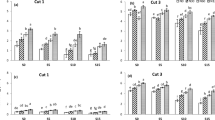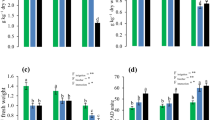Summary
Lowland rice was grown on nutrient solutions in a continuous-flow system, with pH levels varying from 3.5 to 6.0. The chemical compositions of all nutrient solutions were alike, except for small amounts of HCl or KOH, needed for pH adjustments, and for variations in the Al supply.
Rice was found not to be affected in its vegetative growth by H-ion concentrations up to that found at pH 3.5. High acidity suppressed the uptake of metallic cations without affecting vegetative growth.
In low concentrations (0.05 and 0.2 ppm), Al suppressed the growth of rice seedlings. Concentrations ten times higher (0.5 and 2 ppm) appeared to be lethal to young rice plants. In contrast, 2 ppm Al when added to the nutrient solution past the seedling stage, exerted no adverse effect on the growth of rice. Two ppm Al, in chelated form, had no deleterious effect on rice in the seedling stage.
The decreasing sensitivity of lowland rice to Al with advancing age of the plants might be of practical importance in regions where rice is grown on highly acid soils. By allowing the seedlings to develop on a seedbed consisting of soil close to neutrality, the plants may be transplanted into the acid soil once they have lost most of their initial sensitivity to high levels of soluble Al.
Similar content being viewed by others
Literature cited
Aguilar, A., Growth, chemical composition and nitrogen utilization of maize as affected by variations in the pH level of a loess soil. M. Sc. Thesis, Agr. Univ. Wageningen, Netherlands (1973).
Arnon D. I., Fratzke W. E., and Johnson C. M., Hydrogen-ion concentration in relation to absorption of inorganic nutrient by higher plants. Plant Physiol 17, 515–524 (1942).
Arnon D. I. and Johnson C. M., Influence of hydrogen-ion concentration on the growth of higher plants under controlled conditions. Plant Physiol. 17, 525–539 (1942).
Baba, I., Inada, K. and Tajima, K., Mineral nutrition and the occurrence of physiological diseases. In Mineral Nutrition of the Rice Plant. Proc. Symp. I.R.R.I., Los Banjos, Philippines, 173–195 (1964).
Bertrand D. and Wolf A.de, L'aluminium, oligo-élément nécessaire au mais. Compt. Rend. 267 D, 2325–2327 (1960).
Cate R. B. and Sukhai A. P., A study of aluminium in rice soils. Soil Sci. 98, 85–93 (1964).
Chen T. T., Effect of aluminum ion on rice growth. Soils Fertil. Taiwan 65 (1968).
Duncan D. B., Multiple range and multiple F-tests. Biometrics 11, 1–42 (1955).
Dijkshoorn, W., The balance of uptake, ultilization and accumulation of the major elements in grass. Proc. First Reg. Conf. Intern. Potash Inst., Wexford, Ireland, 43–62 (1963).
Foy C. D. and Brown J. C., Toxic factors in acid soils. I. Characterization of aluminum toxicity in cotton. Soils Sci. Soc. Am. Proc. 27, 403–407 (1963).
Hill U. T., New direct spectrophotometric determination of aluminum in steel, spelter, and iron ores, Anal. Chem. 38, 654–656 (1966).
Hutchinson G. E., Aluminum in soils, plants and animals. Soil Sci. 60, 29–40 (1945).
Jackson, W. A., Physiological effects of soil acidity. In Soil Acidity and Liming, Agronomy 12, Madison, Wisc., U.S.A., 43–124 (1967).
Koop F. P. and Diest A. van, The influence of various nitrogen forms on the growth of two rice varieties. Proc. Intern. Symp. Soil Fert. Evaluation, New Delhi 1, 665–678 (1971).
Lindsay W. L., Peech M. and Clark J. S., Solubility criteria for the existence of variscite in soils. Soil Sci. Soc. Am. Proc. 23, 357–360 (1959).
Mc Lean F. T. and Gilbert B. E., Aluminum toxicity. Plant Physiol. 3, 293–302 (1928).
Ota Y., Mode of the occurrence of bronzing in rice plants. Jap. Agr. Research Q 3, 1–5 (1968).
Rees W. J. and Sidrak G. H., Interrelationship of aluminum and manganese toxicities towards plants. Plant and Soil 14, 101–117 (1961).
Schouwenburg J. C. van and Walinga I., Methods of analysis for plant material. Laboratory Outline for M.Sc. Course on Soil Science and Water Management, Agr. Univ. Wageningen, Netherlands (1971).
Tanaka A. and Navasero S. A., Aluminum toxicity of the rice plant under waterculture conditions. Soil Sci. Plant Nutr. 12, (12) 9–14 (1966).
Thawornwong, N., Influences of high acidity and aluminum concentrations in the nutrient solution on the growth of the rice plant (Oryza sativa). M. Sc. Thesis, Agr. Univ. Wageningen, Netherlands (1973).
Wright B. C. and Peech M., Characterization of phosphate reaction products in acid soils by the application of solubility criteria. Soil Sci. 90, 32–43 (1960).
Author information
Authors and Affiliations
Rights and permissions
About this article
Cite this article
Thawornwong, N., Van Diest, A. Influences of high acidity and aluminum on the growth of lowland rice. Plant Soil 41, 141–159 (1974). https://doi.org/10.1007/BF00017951
Received:
Issue Date:
DOI: https://doi.org/10.1007/BF00017951




